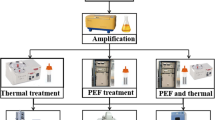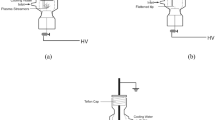Abstract
The inactivation of microorganisms by an electric field was the purpose of this study. It was found that the application of an electric field had a lethal effect on Escherichia coli cells suspended in brain heart infusion broth. Experimental results indicated that the survival rate of E. coli decreased when an electric field with an intensity of 3A was applied during a time equal to 30 min. Mechanisms involved in the sterilization process were discussed. The concentration of proteins and N-acetylglucosamine (NAG) liberated by the cells during the experiment was recorded. The results indicated that the concentration of liberated proteins was 2.21 µg/ml after 5 min, and this concentration increased twofold after 45 min (4.10 µg/ml). The initial concentration of NAG was 0.084 µg/ml. It increased to 0.1 µg/ml after 5 min, to 0.2 µg/ml after 10 min and to 1.3 µg/ml after 30 min.







Similar content being viewed by others
References
Boman HG, Marsh J, Goode JA (1994) Antimicrobial peptides. Ciba Foundation Symposium 186 (eds). Wiley, Chichester
Boudjema N (2014) Traitement des eaux usées de l’Oued El Harrach par electrocoagulation: effects et Mécanismes du Champ Electrique sur les Micro-organismes. These de doctorat biologie, USTHB
Boudjema N, Drouiche N, Abdi N, Grib H, Lounici H, Pauss A, Mameri N (2014) Treatment of Oued El Harrach river water by electrocoagulation noting the effect of the electric field on microorganisms. J Taiwan Inst Chem Eng 45(4):1564–1570
Brogden KA (2005) Antimicrobial peptides: pore formers or metabolic inhibitors in bacteria. Nat Rev 3:238–250
Carson CF, Mee BJ, Riley TV (2002) Mechanism of action of Melaleuca alternifolia (tea tree) oil on Staphylococcus aureus determined par time-kill, lysis, leakage and salt tolerance assays and electron microscopy. Antimicrob Agents Chemother 46:1914–1920
Carson CF, Hammer KA, Riley TV (2006) Melaleuca alternifolia (tea tree) oil: a review of antimicrobial and other medicinal properties. Clin Microbiol Rev 19:50–62
Chen G (2004) Electrochemical technologies in wastewater treatment. Sep Purif Technol 38:11–41
Cox SD, Mann CM, Markham JL, Bell HC, Gustafson JE, Warmington JR, Wyllie SG (2000) The mode of antimicrobial action of the essential oil of Melaleuca alternifolia (tea tree oil). J Appl Microbiol 88:170–175
Gonzalez ME, Barrett DM (2010) Thermal, high pressure, and electric field processing effects on plant cell membrane integrity and relevance to fruit and vegetable quality. J Food Sci 75(7):121–130
Gornall AC, Bardawill CJ, David MM (1949) Determination of serum proteins by means of the biuret reaction. J Bio Chem 177:751–756
Gowrishankar TR, Weaver JC (2003) An approach to electrical modeling of single and multiple cells. Biophys PNAS 100(6):3203–3208
Guinoiseau E (2010) Molécules antibactériennes issues d’huiles essentielles: séparation, identification et mode d’action. Thèse de docteur de l’université de corse, p 148
Hamilton WA, Sale AJH (1967) Effects of high electric fields on microorganisms: II. Mechanism of action of the lethal effect. Biochim Biophys Acta (BBA) Gen Subj 148:789–800
Hammer KA, Carson CF, Riley TV (1996) Susceptibility of transient and commensal skin flora to the essential oil of Melaleuca alternifolia(tea tree oil). Am J Infect Control 24:186–189
Hancock REW (2001) Cationic peptides: effectors in innate immunity and novel antimicrobials. Lancet Infect Dis 1:156–164
Hancock RE, Chapple DS (1999) Peptide antibiotics. Antimicrob Agents Chemother 43:1317–1323
Jenssen H, Hamill P, Hancock RE (2006) Peptide antimicrobial agents. Clin Microbiol Rev 19:491–511
Leontiadou H, Mark AE, Marrink SJ (2006) Antimicrobial peptides in action. J Am Chem Soc 128:12156–12161
Li M, Qu J-h, Peng Y-z (2004) Sterilization Escherichia coli cells by application electric pulsed magnetic field. J Environ Sci 16(2):348–352
Nizet V (2006) Antimicrobial peptide resistance mechanisms of human bacterial pathogens. Curr Issues Mol Biol 8:11–26
Pillet F, Formosa-Dague C, Baaziz H, Dague E, Rols MP (2016) Cell wall as a target for bacteria inactivation by pulsed electric fields. Scientific Reports 6, Article number: 19778
Prescott LM, Harley JP, Klein DA (2003) Microbiologie. de Boeck edn, Bruxelles
Reichling J, Weseler A, Landvatter U, Saller R (2002) Bioactive essential oils used in phytomedicine as antiinfective agents: Australian tea tree oil and manuka oil. Act Pythoter 1:26–32
Reissig JL, Strominger JL, Leloir LF (1955) A modified colorimetric method for estimation of N-acetylmino sugars. J Biol Chem 217:959–962
Sengupta D, Leontiadou H, Mark AE, Marrink SJ (2008) Toroidal pores formed by antimicrobial peptides show significant disorder. Biochem Biophys Acta 1778:2308–2317
Sikkema J, de Bont JAM, Poolman B (1994) Interactions of cyclic hydrocarbons with biological membranes. J Biol Chem 269:8022–8028
Tessaro LWE, Murugan NJ, Persinger MA (2015) Bacterial growth rates are influenced by cellular characteristics of individual species when immersed in electromagnetic fields. Microbiol Res 172:26–33
Tossi A, Scocchi M, Zanetti M, Gennaro R, Storici P, Romeo D (1997) An approach combining rapid cDNA amplification and chemical synthesis for the identification of novel, cathelicidin-derived, antimicrobial peptides. Methods Mol Biol 78:133–150
Vepsalainen M, Pulliainen M, Sillanpa M (2012) A Effect of electrochemical cell structure on natural organic matter (NOM) removal from surface water through electrocoagulation (EC). Sep Purif Technol 99:20–27
Yeaman MR, Yount NY (2003) Mechanisms of antimicrobial peptide action and resistance. Pharmacol Rev 55:27–55
Acknowledgement
This study was financially supported by the National Research Fund from DGRSDT/MESRS (Algeria).
Author information
Authors and Affiliations
Corresponding author
Additional information
Editorial responsibility: M. Abbaspour.
Rights and permissions
About this article
Cite this article
Boudjema, N., Kherat, M., Drouiche, N. et al. Investigation of the mechanisms of Escherichia coli cells sterilization by the application of an electric field. Int. J. Environ. Sci. Technol. 16, 6259–6266 (2019). https://doi.org/10.1007/s13762-019-02218-5
Received:
Revised:
Accepted:
Published:
Issue Date:
DOI: https://doi.org/10.1007/s13762-019-02218-5




